
 Greater ani, Crotophaga major
Greater ani, Crotophaga majorMost of these birds were photographed from Pipeline Road in Parque Nacional Soberania .
Anis are in the cuckoo family.
 Smooth-billed ani, Crotophaga ani
Smooth-billed ani, Crotophaga ani
Antbirds and Antshrikes are small birds with rounded wings and strong legs.


 Spotted antbird (males left, female right) Hylophylax naevioides
Spotted antbird (males left, female right) Hylophylax naevioides
 Bicolored antbird, Gymnopithys bicolor
Bicolored antbird, Gymnopithys bicolor
 Fasciated antshrike (male), Cymbilaimus lineatus
Fasciated antshrike (male), Cymbilaimus lineatus
Caciques are New World forest blackbirds.
 Yellow-rumped cacique, Cacicus cela
Yellow-rumped cacique, Cacicus cela
Caracaras are South American falcons.
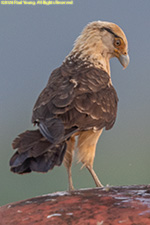

 Yellow-headed caracara (adults left, juvenile right), Daptrius chimachima
Yellow-headed caracara (adults left, juvenile right), Daptrius chimachima
Chachalacas are noisy social ground-feeding birds found in wooded habitats.
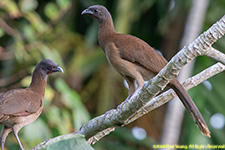 Gray-headed chachalaca, Ortalis cinereiceps
Gray-headed chachalaca, Ortalis cinereiceps
Cotingas have broad bills with hooked tips, rounded wings, and strong legs. They eat primarily fruits.

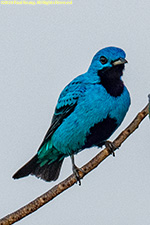 Turquoise cotinga (female left, male right), Cotinga ridgwayi
Turquoise cotinga (female left, male right), Cotinga ridgwayi
Ducks:
 Black-bellied whistling (tree) duck, Dendrocygna autumnalis, is a mis-sized waterfowl.
Black-bellied whistling (tree) duck, Dendrocygna autumnalis, is a mis-sized waterfowl.
Euphonias are Neotropical finches.
 Thick-billed euphonia, Euphonia laniirostris
Thick-billed euphonia, Euphonia laniirostris

 Fulvous-vented euphonia (female left, male right), Euphonia fulvicrissa
Fulvous-vented euphonia (female left, male right), Euphonia fulvicrissa
Flycatchers, kingbirds, and kiskadees are small passerine birds. There are more than four hundred species.


 Tropical kingbird, Tyrannus melancholicus
Tropical kingbird, Tyrannus melancholicus

 Social flycatcher, Myiozetetes similis
Social flycatcher, Myiozetetes similis
 Great crested flycatcher, Myiarchus crinitus
Great crested flycatcher, Myiarchus crinitus
 Olive-striped flycatcher, Mionectes galbinus
Olive-striped flycatcher, Mionectes galbinus
 Boat-billed flycatcher, Megarynchus pitangus
Boat-billed flycatcher, Megarynchus pitangus

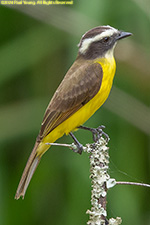 Great kiskadee, Pitangus sulphuratus
Great kiskadee, Pitangus sulphuratus

 Dusky-capped flycatcher, Myiarchus tuberculifer
Dusky-capped flycatcher, Myiarchus tuberculifer
 Streaked flycatcher, Myiodynastes maculatus
Streaked flycatcher, Myiodynastes maculatus
Gnatcatchers are small passerine birds related to wrens. There are 21 species.
 White-browed gnatcatcher, Polioptila bilineata
White-browed gnatcatcher, Polioptila bilineata
Grassquits are small tropical tanagers.
 Blue-black grassquit (female), Volatinia jacarina
Blue-black grassquit (female), Volatinia jacarina
Grosbeaks:are various species of seed-eating passerine birds with large beaks.
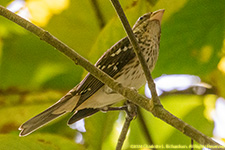 Rose-breasted grosbeak (female), Pheucticus ludovicianus
Rose-breasted grosbeak (female), Pheucticus ludovicianus
Hawks are birds of prey.
 Common black hawk (juvenile), Buteogallus anthracinus
Common black hawk (juvenile), Buteogallus anthracinus
Herons and egrets: Herons are long-legged, long-necked freshwater and coastal birds. Egrets generally have white or buff plumage,
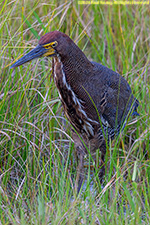 Rufescent tiger-heron, Tigrisoma lineatum
Rufescent tiger-heron, Tigrisoma lineatum


 Little blue heron (adults left, immature right), Egretta caerulea
Little blue heron (adults left, immature right), Egretta caerulea
 Snowy egret (immature), Egretta thula
Snowy egret (immature), Egretta thula

 Tricolored heron, Egretta tricolor
Tricolored heron, Egretta tricolor
 Green heron, Butorides virescens
Green heron, Butorides virescens
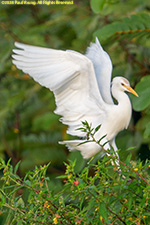
 Western cattle egret, Bubulcus ibis
Western cattle egret, Bubulcus ibis
Honeycreepers are small tropical New World birds in the tanager family. They are specialist nectar feeders with long, curved bills.

 Red-legged honeycreeper (female left, male right), Cyanerpes cyaneus
Red-legged honeycreeper (female left, male right), Cyanerpes cyaneus

 Green honeycreeper (nale left, female right), Chlorophanes spiza
Green honeycreeper (nale left, female right), Chlorophanes spiza
Hummingbirds are native to the Americas, mostly found in Central and South America. There are around 366 species. They are capable of rapid, maneuverable flight.



 Blue-chested hummingbird (female left, males right), Polyerata amabilis
Blue-chested hummingbird (female left, males right), Polyerata amabilis

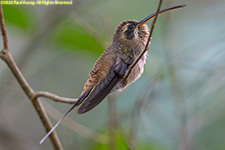 Long-billed hermit, Phaethornis longirostris
Long-billed hermit, Phaethornis longirostris





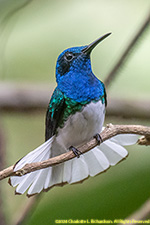
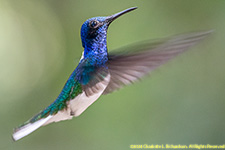


 White-necked Jacobin (females left, males right), Florisuga mellivora
White-necked Jacobin (females left, males right), Florisuga mellivora

 Violet-bellied hummingbird, Chlorestes julie
Violet-bellied hummingbird, Chlorestes julie
Jacanas and gallinules: The two species of jacanas both have long necks, long yellow bills, frontal shields, and very long toes. Gallinules (moorhens or marsh hens) are medium-sized water birds related to rails and coots. They have short rounded wings and are weak fliers, but have strong legs and long toes.

 Wattled jacana (adult left, immature right), Jacana jacana
Wattled jacana (adult left, immature right), Jacana jacana

 Purple gallinule, Porphyrio martinica
Purple gallinule, Porphyrio martinica
Kites are birds of prey.
 Snail kite (immature), Rostrhamus sociabilis
Snail kite (immature), Rostrhamus sociabilis
Lapwings are gound-nesting birds related to plovers and dotterels.
 Southern lapwing, Vanellus chiliensis
Southern lapwing, Vanellus chiliensis
Mockingbirds are New World passerine birds. Some species mimic the songs of other birds and the sounds of insects and amphibians.
 Tropical mockingbird, Mimus gilvus
Tropical mockingbird, Mimus gilvus
Motmots are a family of birds related to kingfishers, bee-eaters, and rollers. The 10 species are endemic to Neotropical woodlands and forests, and six are found in Central America. Many have long tails with a distinctive racket-like tip.

 Rufous motmot, Baryphthengus martii
Rufous motmot, Baryphthengus martii


 Broad-billed motmot, Electron platyrhynchum
Broad-billed motmot, Electron platyrhynchum
 Whooping motmot, Momotus subrufescens
Whooping motmot, Momotus subrufescens
Oropendolas are vocal New World blackbirds found in Central and South America. They are large birds with pointed bills and long tails which are at least partially yellow. They are colonial breeders, building woven basket nests hanging from the tips of branches.

 Chestnut-headed oropendola, Psarocolius wagleri
Chestnut-headed oropendola, Psarocolius wagleri
Ospreys are large diurnal, fish-eating birds of prey.
Parrots and parakeets: Parrots have a strong, curved beak, upright stance, and clawed feet. Parakeets are small to medium-sized parrots, generally with long tail feathers.
 Red-lored parrot, Amazona autumnalis
Red-lored parrot, Amazona autumnalis

 Orange-chinned parakeet, Brotogeris jugukaris
Orange-chinned parakeet, Brotogeris jugukaris
Pigeons and doves are stout-bodied birds with short necks and short slender bills.

 Scaled pigeon, Patagioenas speciosa
Scaled pigeon, Patagioenas speciosa
 Short-billed pigeon, Patagioenas nigrirostris
Short-billed pigeon, Patagioenas nigrirostris
 Ruddy ground dove, Columbina talpacoti
Ruddy ground dove, Columbina talpacoti
Seedeaters are seed-eating passerine birds with a distinctively conical bill.



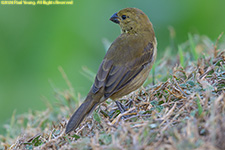

 Variable seedeater, Sporophila corvina
Variable seedeater, Sporophila corvina
Tanagers and dacnis: Tanagers are a large family of small to medium-sized brightly-colored fruit-eating Neotropical birds.
 Palm tanager, Thraupis palmarum
Palm tanager, Thraupis palmarum
 Plain-colored tanager, Tangara inornata
Plain-colored tanager, Tangara inornata
 Summer tanager (female), Piranga rubra
Summer tanager (female), Piranga rubra
 White-shouldered tanager (male), Loriotus luctuosus
White-shouldered tanager (male), Loriotus luctuosus
 Blue-gray tanager, Thraupis episcopus
Blue-gray tanager, Thraupis episcopus

 Blue dacnis (female left, male right), Dacnis cayana
Blue dacnis (female left, male right), Dacnis cayana
 Flame-rumped tanager (female), Ramphocelus flammigerus
Flame-rumped tanager (female), Ramphocelus flammigerus


 Crimson-backed tanager, Ramphocelus dimidiatus
Crimson-backed tanager, Ramphocelus dimidiatus
 Golden-hooded tanager, Stilpnia larvata
Golden-hooded tanager, Stilpnia larvata
Thrushes are plump, soft-plumaged small to medium-sized passerine birds with a worldwide distribution.
 Clay-colored thrush (robin), Turdus grayi
Clay-colored thrush (robin), Turdus grayi
Tinamous are shy sedentary ground-dwelling birds that are active during the day and retire to roosts at night. These ancient birds are related to the ostrich and emu. ther are some 45 species.
Tityras are medium-sized passerine birds with large bills.

 Masked tityra (female), Tityra semifascuata
Masked tityra (female), Tityra semifascuata
Toucans and aricaris: Toucans are Neotropical birds related to American barbets. They are brightly colored and have large, often colorful bills. Aricaris are medium-sized toucans.


 Keel-billed toucan, Ramphastos sulfuratus
Keel-billed toucan, Ramphastos sulfuratus


 Collared aricari, Pteroglossus torquatus
Collared aricari, Pteroglossus torquatus
Trogons are related to quetzals. They gnaw holes in trees or termite nests to make their nests, and have broad bills and weak legs.


 White-tailed trogon (males left, female right), Trogon chionurus
White-tailed trogon (males left, female right), Trogon chionurus



 Northern black-throated trogon (left males, right females), Trogon tenellus
Northern black-throated trogon (left males, right females), Trogon tenellus
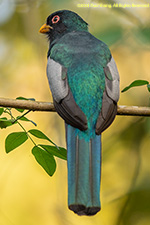
 Slaty-tailed trogon (male), Trogon massena
Slaty-tailed trogon (male), Trogon massena


 Gartered trogon (nales left, female right), Trogon caligatus
Gartered trogon (nales left, female right), Trogon caligatus
Tyrannulets are tyrant flycatchers, New World passerine birds.
 Mistletoe tyrannulet, Zimmerius parvus
Mistletoe tyrannulet, Zimmerius parvus
Vultures are birds of prey with bald, unfeathered heads that scavange on carrion. There are seven New World species.

 Black vulture, Coragyps atratus
Black vulture, Coragyps atratus

 Turkey vulture, Cathartes aura
Turkey vulture, Cathartes aura
Warblers are small, vocal, insectivorous perching birds that are not anecessarily closely related to each other.

 Chestnut-sided warbler (female or immature), Setophaga pensylvanica
Chestnut-sided warbler (female or immature), Setophaga pensylvanica
 Bay-breasted warbler, Setophaga castanea
Bay-breasted warbler, Setophaga castanea


 Yellow warbler (female), Setophaga petechia
Yellow warbler (female), Setophaga petechia
Woodcreepers are related to ovenbirds and are endemic to the Neotropics.
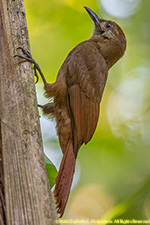 Plain-brown weedcreeper, Dendrocincla fuliginosa
Plain-brown weedcreeper, Dendrocincla fuliginosa
 Northern barred-woodcreeper, Dendrocolaptes sanctihomae
Northern barred-woodcreeper, Dendrocolaptes sanctihomae
Woodpeckers forage for insect prey on the trunks and branches of trees, excavating holes in tree trunks.
 Lineated woodpecker (female), Dryocopus lineatus
Lineated woodpecker (female), Dryocopus lineatus


 Red-crowned woodpecker (males left, female right), Melanerpes rubricapillus
Red-crowned woodpecker (males left, female right), Melanerpes rubricapillus
Wrens are brown passerine birds.
 Isthmian wren, Cantorchilus elutus
Isthmian wren, Cantorchilus elutus
©2024 Mermaid Underwater Photographic. All Rights Reserved.
Contact us at mermaid@underwater.org.
Last modified 19 February 2024